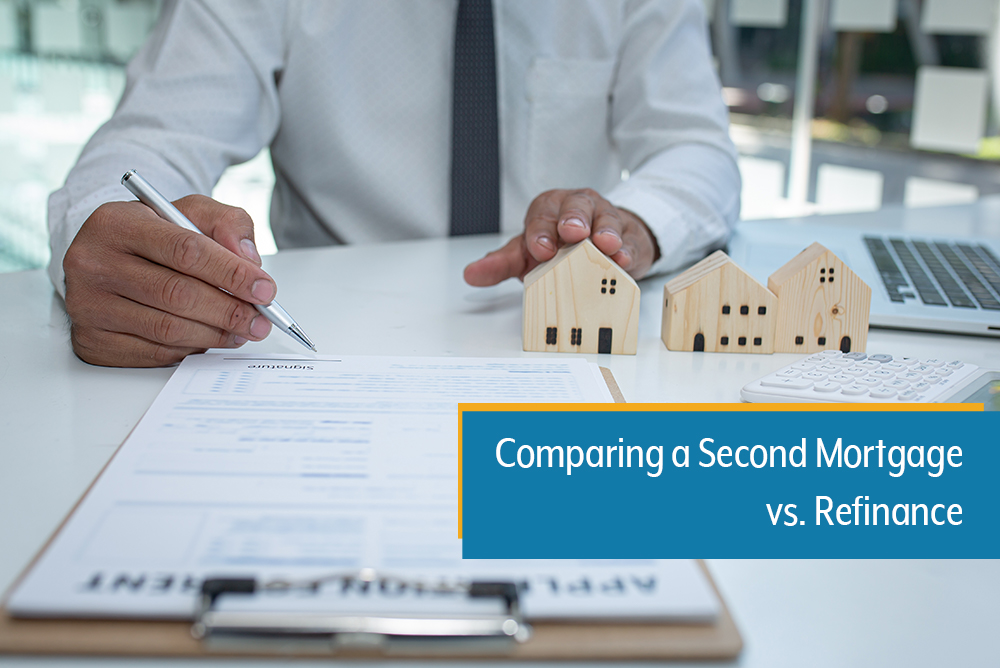
Comparing a Second Mortgage vs. Refinance
Tags:
Are you a Canadian homeowner looking to tap into the equity of your home, or benefit from lower monthly payments or rates? If so, then you may be considering either a second mortgage or a refinancing of your current mortgage.
While both of these options enable homeowners to use their property as collateral to borrow money, there are considerable differences between the two that are important and useful to understand.
In this article, we’ll compare both second mortgages and refinancing to help you determine which option may be best for your current financial situation and mortgage needs.
What is a second mortgage?
A second mortgage is a loan taken out against the equity in a home already being used as collateral for a first mortgage. Generally, the first mortgage is the primary loan that was used to purchase the house, and the second mortgage is a separate loan that is taken out on top of the first mortgage.
With that being said, second mortgages are usually offered in the form of either a home equity loan or a home equity line of credit (HELOC). However, how do the two differ?
A home equity loan is a lump sum loan that the borrower receives all at once, and is to be paid back over a certain period of time through fixed monthly payments. On the other hand, a HELOC is a revolving line of credit in which borrowers receive loan proceeds on an on-needed basis and will make payments on as they continue to borrow money. The interest rate on a HELOC is typically adjustable, meaning that it can change over time depending on the conditions of the market.
Advantages and Drawbacks of Second Mortgages
Second mortgages can be a viable option for homeowners with equity in their homes, who need to borrow a large sum of money and appreciate the security of fixed monthly payments.
Second mortgages also present several unique advantages, such as allowing borrowers to keep their current loan term without making sacrifices (e.g. keeping the low interest rates of a primary mortgage). The flexibility of choosing between a lump sum loan or HELOC serves as another attractive benefit for homeowners.
However, second mortgages have some potential drawbacks. One of the main drawbacks is that they are a second lien on the property, which means that the first mortgage lender has priority in the event that the borrower defaults on their loans. This means that if the borrower falls behind on their payments, the first mortgage lender can foreclose on the home before the second mortgage lender can.
In addition, second mortgages may have higher interest rates than first mortgages because they are considered a higher risk for lenders. This means that homeowners who take out a second mortgage may end up paying more in interest over the life of the loan, depending on their unique circumstances.
What is a refinance?
A refinance is a process in which a homeowner replaces their current mortgage with a new mortgage containing different terms. However, they are essentially taking out a new loan to pay off their existing mortgage.
Homeowners may choose to refinance their mortgages for a variety of reasons, including to lower their monthly mortgage payments and pay off their mortgage faster, obtain a lower interest rate, alter the term of the loan, switch from an adjustable-rate mortgage to a fixed-rate mortgage, or to access the equity in their homes.
Advantages and Drawbacks of Refinancing
Under the right circumstances, a mortgage refinance can help to free a homeowner of financial burdens through significant cost savings. They require borrowers to pay only single mortgage payments each month, and offer the opportunity for beneficial adjustments of mortgage terms and rates.
However, just like with a second mortgage, refinancing can also have potential drawbacks. For example, a refinance may be costly in the short term, as homeowners may need to pay higher closing costs along with other fees associated with taking out a new mortgage.
Furthermore, refinancing a mortgage may require homeowners to pay for a new home appraisal, and may also be required to accept different (and higher) interest rates.
Finally, refinancing may extend the term of a homeowner’s mortgage. This means that if a homeowner refinances their mortgage to get a lower monthly payment, they may end up paying more in interest over the life of the loan since they are technically stretching the loan out over a longer period of time.
Second Mortgage vs. Refinance: Which one is right for you?
When it comes time to decide between a second mortgage and a refinance, homeowners should consider their financial goals in both the short and long term, in addition to the specific terms of the loans being offered.
As always, it is advised to work with a trusted mortgage solution provider, such as our experts at Canadalend, to help you choose a solution that will be most financially beneficial for you.
Considering a second mortgage or refinance?
Our mortgage lenders in Ontario are here to lend a hand. Canadalend.com can help you determine whether a second mortgage or a refinance is a better option for you, so you can take the right steps toward achieving your financial goals.
To learn more about our second mortgage solutions and refinancing options, call Canadalend.com at 1-866-I CAN LEND or contact us here.